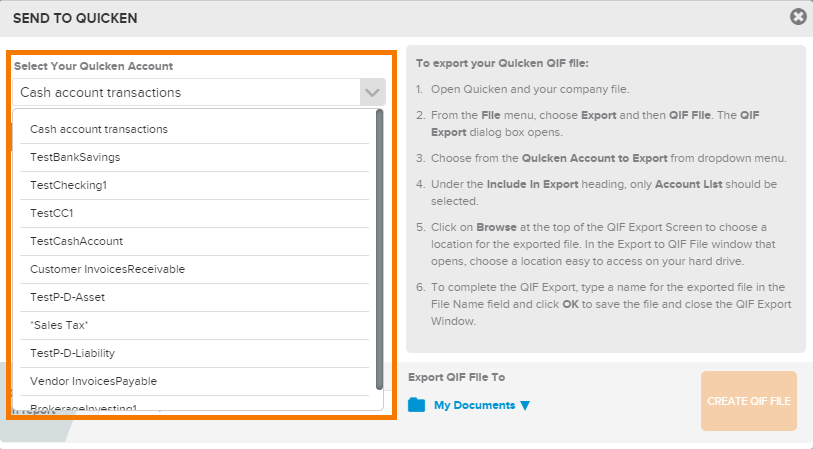

- #QUICKEN QIF FILE EXPORT HOW TO#
- #QUICKEN QIF FILE EXPORT FOR MAC#
- #QUICKEN QIF FILE EXPORT FULL#
- #QUICKEN QIF FILE EXPORT CODE#
How to convert CSV/Excel file to QIF and import into Quicken 2017 for PC Convert CSV/Excel to QIF and import into Quicken 2018 Starter Edition for PC How to. You do need to have a CUSIP number for every security to create a proper QFX file that Quicken can import. Once you have a QDF file opened, export data as a QIF file and use the Transactions app, QIF2CSV, or Bank2CSV to export your data to CSV or Excel/XLS/XLSX format. For the QFX (OFX) case, each transaction must be accompanied by the security record with CUSIP supplied. You need to make sure your securities names do match the ones on the QIF file, but nothing more. In File Location field, navigate to the location where the file will be saved. In the Export dialog, type a name for the exported QIF file in the File Name field.

In the toolbar, click XL2QIF then select Save to QIF.
#QUICKEN QIF FILE EXPORT FULL#
When you import a QIF file with investment transactions under Quicken (or MS Money), Quicken will look up the security by its full name. Next, open Microsoft Excel then open the file you need to convert to QIF. That’s it, no ticker symbol, no CUSIP numbers, just full Security name. QIF format simplifies investment transactions by limiting security identification to just the security name. It should be ok for most payees, but not retailer stores, like Walmart. There is a workaround (no great, but some) this limitation for categories: you can set “rename rules” in Quicken to have categories assigned to specific payee names. On the other hand, the QIF format still imports categories and tags just fine. QFX format as extended OFX format with additional Quicken only details, but the OFX specification does not provide category or tag attribute for transactions (or anything else similar) That’s it you cannot import categories and tags assigned to your transactions using the QFX (Web Connect) format. The cure for that is simple: edit account, click on the “Online Services” tab, and select “deactivate online link”. If you have other QFX files with different settings then your currently for the account in “online link”, Quicken will not allow you to import that other QFX file under the “occupied” account. Once a QFX file is imported under an account in Quicken you choose during the import, it “online links” that account to bank settings supplied in that QFX file. Some banks come and go, so your bank may drop QFX support tomorrow.
#QUICKEN QIF FILE EXPORT CODE#
Quicken checks if the bank code supplied in the QFX file is ‘allowed’ by Quicken for a specific bank and even more bank account type. Quicken does not do any “home calls” during QIF imports, but it does every time you are trying to import a QFX file (yes, you need the Internet connection, your firewall must allow Quicken to go through just to import a QFX file that you have locally on your computer). CSV2QIF - CSV/XLS/XLSX to QIF converter, Bank2QIF - CSV, XLS, XLSX, PDF, QFX, OFX, QBO, QIF, MT940, STA to QIF converter, The Transactions app, which converts from more formats and converts to more formats - will help you create those files. They're slightly different, “Quicken only”, QIF files that Quicken 2012 imports just fine under any account. Guess what, unless you have Quicken Essentials for Mac, QIF files are fully supported, but not the ones your bank offers you for download.

On the QIF import screen Quicken tells, then you can import a QIF file only under cash account, offering in the drop-down choice for account selection only cash accounts, but also “All Account” as well.
#QUICKEN QIF FILE EXPORT FOR MAC#
ImportQEM converts a CSV file with transaction data from Quicken Essentials for Mac to a QIF file that then can be imported into Quicken for Windows or Quicken Mac. Requirements ImportQEM has been tested on Quicken 2005-2018 US, Windows 10, 8.1, 8, 7, XP, but it should also work on Vista. Quicken claims that the QIF format is outdated, and not supported anymore, however, still allows importing a QIF file. Quicken stores the file in the Quicken folder by default. Here are the major differences between QIF and QFX (Web Connect) format when you try to import them under Quicken: Vendor Support Quicken for Windows up to the latest 2021 (and 2020, 2019) version, supports import for QIF and QFX (Web Connect) files.

uncompress and ungzip both say its not recognizable. But when I look at the QFX output file that Quicken produces, it is a binary file. QFX is suppose to be OFX which is an xml format. So I'm very curious in what the QXF file contains. When I export it to a QXF file, I do not get warnings and the file is 3M. When I export it to a QIF file, I get warnings and the file is 141K. Quicken on a Mac has two ways to export all the data: to a QIF file and a QXF file.


 0 kommentar(er)
0 kommentar(er)
